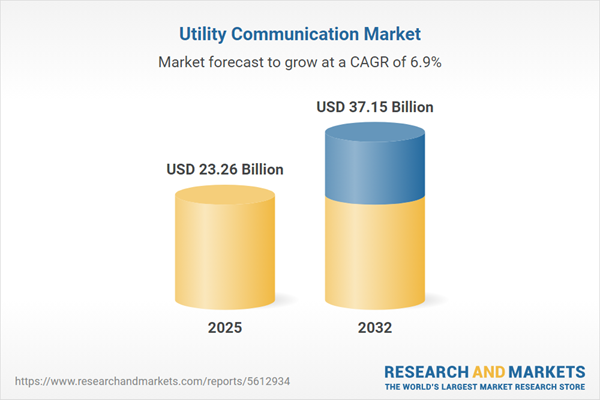Speak directly to the analyst to clarify any post sales queries you may have.
The utility communication market is entering a transformative phase as utilities overhaul infrastructure for improved connectivity, resilience, and efficiency in a shifting regulatory and technology landscape.
Market Snapshot: Utility Communication Market Growth & Outlook
The Utility Communication Market grew from USD 21.75 billion in 2024 to USD 23.26 billion in 2025. It is expected to continue growing at a CAGR of 6.91%, reaching USD 37.15 billion by 2032. This expansion is fueled by sustained investment in grid modernization, widespread digitization, and increasing demand for real-time monitoring and automated control across electric, gas, and water utilities. Evolving regulatory demands and complex procurement environments are further accelerating adoption of advanced communication solutions worldwide.
Scope & Segmentation: Comprehensive Coverage of the Utility Communication Landscape
- Communication Technology: Wired (Digital Subscriber Line, Fiber Optic Communication, Power Line Communication), Wireless (Cellular Communication, Radio Frequency Mesh, Satellite Communication)
- Utility Type: Electric, Gas, Water
- Application: Distribution Automation, Fault Management, Metering (Automatic Meter Reading, Smart Metering), Supervisory Control and Data Acquisition
- Deployment Type: Cloud Based, On Premise
- End User: Commercial, Industrial, Residential
- Regional Coverage: Americas (North America: United States, Canada, Mexico; Latin America: Brazil, Argentina, Chile, Colombia, Peru), Europe, Middle East & Africa (Europe: United Kingdom, Germany, France, Russia, Italy, Spain, Netherlands, Sweden, Poland, Switzerland; Middle East: United Arab Emirates, Saudi Arabia, Qatar, Turkey, Israel; Africa: South Africa, Nigeria, Egypt, Kenya), Asia-Pacific (China, India, Japan, Australia, South Korea, Indonesia, Thailand, Malaysia, Singapore, Taiwan)
- Key Companies: Siemens Aktiengesellschaft, Schneider Electric SE, ABB Ltd, Itron Inc., Landis+Gyr AG, Cisco Systems Inc., General Electric Company, Huawei Technologies Co. Ltd., Telefonaktiebolaget LM Ericsson (publ), Nokia Corporation
Key Takeaways: Strategic Insights for Utility Communication Stakeholders
- The convergence of wired and wireless infrastructure is giving utilities the flexibility needed for scalable, reliable network design in distributed energy environments.
- Utility communication systems increasingly rely on edge computing and cloud-native platforms to support real-time analytics, decentralized control, and predictive maintenance.
- Adoption of digital twins and advanced simulation tools enhances network performance modeling and informs smarter capital planning.
- Heightened security requirements drive investment in advanced encryption, multifactor authentication, and network segmentation to safeguard critical infrastructure.
- Regional investment strategies diverge, with developed markets pursuing fiber-based modernization and emerging regions favoring hybrid wireless deployments for coverage and cost efficiency.
- Leading industry players are strengthening their market position through strategic collaborations, regional service expansions, and the integration of AI-driven solutions to improve asset utilization and resilience.
Tariff Impact: Navigating Supply Chain and Procurement Challenges
Recent tariff adjustments in the United States have increased procurement costs for essential communication components. Utilities are reassessing supplier relationships, emphasizing regional manufacturing, and updating inventory strategies to address supply disruptions and cost volatility. These dynamics influence both investment timing and project execution, requiring careful alignment between policy adaptation and long-term grid modernization priorities.
Methodology & Data Sources
This report leverages a robust blend of primary and secondary research, including regulatory filings, technical studies, peer-reviewed publications, and executive interviews. Data triangulation ensures a balanced perspective, with qualitative and quantitative findings substantiated by real-world deployment observations, trade database analysis, and iterative expert validation.
Why This Report Matters
- Enables senior decision-makers to anticipate market disruptions and leverage strategic opportunities in evolving utility communication ecosystems.
- Delivers segmented insights to optimize capital planning, supplier selection, and technology adoption across regions and utility types.
- Supports informed responses to regulatory, security, and tariff-driven pressures for improved service reliability and cost management.
Conclusion
This market research delivers actionable intelligence for executives navigating complex technology choices, evolving compliance landscapes, and shifting global dynamics in utility communication. Proactive strategy and agile execution will be essential for sustaining operational excellence and competitive advantage.
Additional Product Information:
- Purchase of this report includes 1 year online access with quarterly updates.
- This report can be updated on request. Please contact our Customer Experience team using the Ask a Question widget on our website.
Table of Contents
3. Executive Summary
4. Market Overview
7. Cumulative Impact of Artificial Intelligence 2025
Companies Mentioned
The companies profiled in this Utility Communication market report include:- Siemens Aktiengesellschaft
- Schneider Electric SE
- ABB Ltd
- Itron, Inc.
- Landis+Gyr AG
- Cisco Systems, Inc.
- General Electric Company
- Huawei Technologies Co., Ltd.
- Telefonaktiebolaget LM Ericsson (publ)
- Nokia Corporation
Table Information
| Report Attribute | Details |
|---|---|
| No. of Pages | 194 |
| Published | October 2025 |
| Forecast Period | 2025 - 2032 |
| Estimated Market Value ( USD | $ 23.26 Billion |
| Forecasted Market Value ( USD | $ 37.15 Billion |
| Compound Annual Growth Rate | 6.9% |
| Regions Covered | Global |
| No. of Companies Mentioned | 11 |









